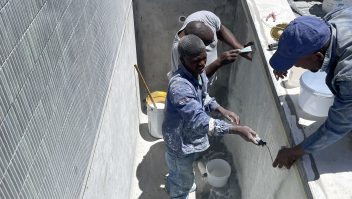When maintaining a crystal-clear pool, getting your stabilizer levels right is essential. Pool stabilizer—also known as cyanuric acid (CYA)—helps protect chlorine from being broken down by sunlight. Without the right amount, your chlorine can burn off quickly, making your pool harder (and more expensive) to maintain. Our Pool Stabilizer Calculator helps you determine exactly how much CYA to add to your pool to reach the ideal levels.
Why Pool Stabilizer Matters
Sunlight can destroy up to 90% of your free chlorine in just a few hours. That’s where stabilizer steps in. CYA acts like sunscreen for chlorine, helping it last longer and work more efficiently. However, adding too much stabilizer can actually reduce chlorine effectiveness. That’s why it’s important to measure and dose correctly.
Ideal Stabilizer Levels
- Saltwater Pools: 60–80 ppm
- Traditional Chlorine Pools: 30–50 ppm
- Indoor Pools: Typically, no stabilizer is needed
Too little? Chlorine won’t last. Too much? Chlorine becomes sluggish and ineffective. The sweet spot is key.
How to Use the Pool Stabilizer Calculator
To calculate how much stabilizer you need, you’ll need:
- Your pool’s total volume (in litres)
- Your current stabilizer (CYA) level
- Your target stabilizer level
Basic formula:
Amount of CYA needed (grams) = (Target CYA – Current CYA) × Pool Volume (L) ÷ 1000
Example:
Let’s say your pool is 50,000 litres, and your CYA level is 20 ppm. You want to increase it to 50 ppm:
(50 – 20) × 50,000 ÷ 1000 = 1,500 grams of cyanuric acid
Tips for Adding Pool Stabilizer
- Use a sock or skimmer method: Slowly dissolve stabilizer granules in a sock inside the skimmer or hang it near a return jet.
- Avoid dumping it directly into the pool: It can settle and damage pool surfaces.
- Test again after a few days: Stabilizer takes time to dissolve and show accurate readings.
Maintenance Tip
Once added, CYA doesn’t evaporate—it only leaves through backwashing, splash-out, or water dilution. So be cautious and avoid overdoing it. If your level is too high, partial draining may be required.
Internal Links
- Pool pH Calculator: How To Get Your pH Level In Range
- How to Maintain Your Pool
- Pool Chlorine Calculator: How Much Chlorine Do You Need to Add?
External Links
FAQ Section
1. What is pool stabilizer made of?
Pool stabilizer is typically made of cyanuric acid, which helps protect chlorine from being broken down by UV rays.
2. Can I add too much stabilizer to my pool?
Yes. High stabilizer levels can reduce chlorine’s effectiveness, leading to cloudy water or algae growth. The only fix is dilution or partial draining.
3. How often should I test my stabilizer level?
Test it monthly, especially during peak swimming season or after heavy rainfall and backwashing.
4. Do saltwater pools need stabilizer?
Yes. Even though salt systems generate chlorine automatically, the chlorine still needs protection from the sun.
5. Is stabilizer harmful to swimmers?
When used at recommended levels, stabilizer is safe. Overuse, however, can lead to chemical imbalances that irritate skin and eyes.
Getting your stabilizer level right is one of the smartest ways to make your chlorine work harder for longer. Use our Pool Stabilizer Calculator to fine-tune your chemical levels and enjoy a cleaner, clearer pool all season long. Need help testing or balancing your pool water in Cape Town? Contact Pools Reno for expert service and advice.
3. Pool pH Calculator: How To Get Your pH Level In Range.



